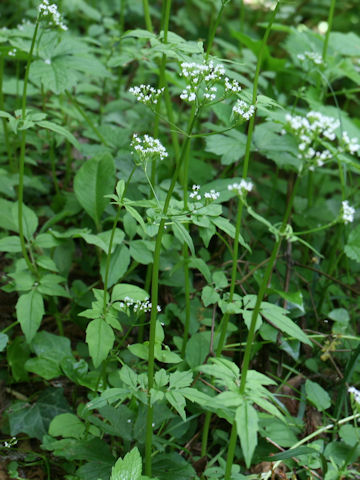 |
























|

|
わが国の本州から四国・九州それに台湾や中国中南部に分布しています。山地の林床や谷沿いなど湿ったところに生え、高さは20〜40センチになります。根生葉は広卵形で、茎葉は羽状に3〜7裂します。縁には波打った鋸歯があります。4月から5月ごろ、中空の茎を伸ばして、先端に集散花序をだし、小さな白色の花を咲かせます。和名は、茎の基部から走出枝(Runner)をだして広がることから。若い茎は山菜として利用されます。台湾華語では「嫩莖纈草」、中国語では「柔垂纈草(rou chui xie cao)」と呼ばれます。
|

|
オミナエシ科カノコソウ属の多年草で、学名は Valeriana flaccidissima。英名はありません。
|

|
The "Tsuru-kanoko-so" (Valeriana flaccidissima) belongs to Valerianaceae (the Valerian family). It is a perennial herb that is distrubuted from Honshu to Shikoku and Kyushu in Japan, as well as Taiwan and mid-southern China. This herb grows in damp places such as forest floors in the mountains and along valleys, and can reach 20-40 cm in height. The basal leaves are broad-ovate, and the cauline leaves split pinnately into 3 to 7 lobes. There are wavy serrations on the edges. The hollow stems are extended, the inflorescences are borne on the tips, and the small white flowers bloom from April to May. The Japanese name comes from the fact that it spreads out from the base of the stem with runners. The young stems are used as wild vegetables. It is called "嫩莖纈草" in Taiwanese Chinese and "柔垂纈草" (rou chui xie cao) in Chinese.
|

|
[上・中1・中3] 大阪府河内長野市滝畑「岩湧山」にて、2006年05月15日撮影。
[中2] 兵庫県山崎町土万「八重谷峠」にて、2004年04月22日撮影。
[中4〜中6] 宮城県山元町「深山」にて、2020年05月01日撮影。
[中7〜中9] 宮城県仙台市太白区「太白山」にて、2021年05月08日撮影。
[中10・下] 福島市松川町「水原地区くまがいそう自生地」にて、2023年05月04日撮影。
|













